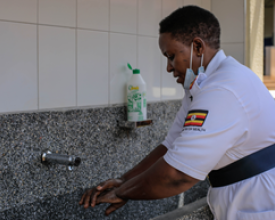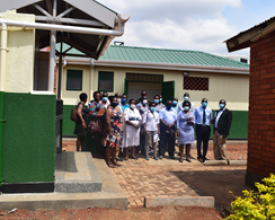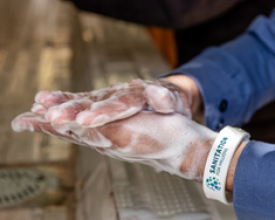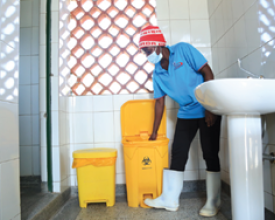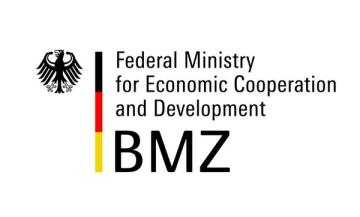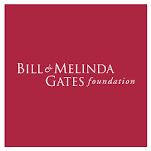
Sanitation for Millions Approach to One Health in Health Care Facilities
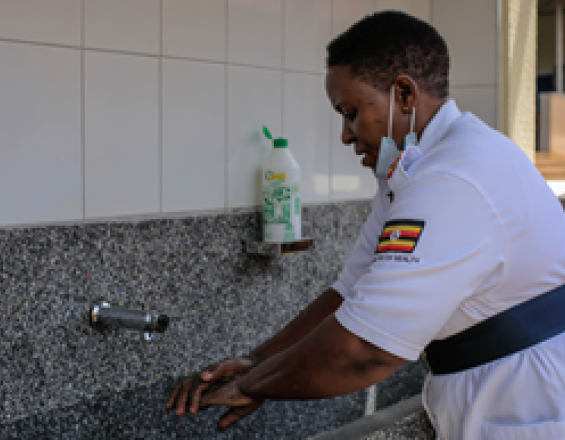
The global pandemic has shown societies’ vulnerability to highly infectious diseases due to Antimicrobial Resistance (AMR). It has revealed critical weaknesses in primary Health Care Facilities (HCFs), such as inadequate infection prevention and control, lack of proper waste management or infrastructural deficits. Improper excreta disposal and medical waste management are linked to the spread of vectors, vermin, and other germs. They have been associated with spreading pharmaceutical residues that contribute to increased AMR. This is the point of departure of Sanitation for Millions towards applying One Health through a WASH in HCFs approach. The project has designed a framework for its interventions based on GIZ knowledge, experience in partner countries, the Joint Monitoring Programme of WHO/UNICEF, and national policies. It is based on capacity building, promoting hygiene management, creating awareness, and designing an enabling environment that targets the reducing health risks and protecting human health.
Context
Challenges addressed
One of the most serious issues facing global health is the lack of safe WASH in HCFs. Safe water, functioning sanitary facilities, and soap must be present in all HCFs around the world in order to provide safe and dignified care, protect women and new-borns during childbirth, prevent infections in patients and staff, carry out safe surgery, and prevent and contain pandemics and antibiotic resistance. As the majority of healthcare workers and those utilizing healthcare services are women, the lack of WASH in HCFs disproportionately affects them.
Globally, 3.85 billion people lack a basic hygiene service at their HCF, 1.7 billion people lack a basic water service at their HCF, and 780 million people have no improved toilets at their HCF. Furthermore, the extent of the problem remains hidden because major gaps in data persist. To address growing waste challenges create the neccesity for investment additional waste treatment capacity and systems to ensure their sustained operation.
Location
Process
Summary of the process
In high traffic and populated HCFs, patients and healthcare workers need appropriate and user-friendly WASH facilities. Sanitation for Millions strengthens good hygiene practices through a unique model that focuses on a ‘WASH needs-based’ combination of infrastructure, awareness and practice-oriented measures. This model responds to the individual needs of the users of the HCFs, including women and girls, people with disabilities and other vulnerable population groups.
Sanitation for Millions employs a combination of construction of toilets, handwashing stations and hospital waste management facilities to promote improved access to safe and equitable sanitation and hygiene. These measures are accompanied with awareness campaigns and training support to foster improved WASH knowledge and practices with a focus on infection prevention and control (IPC).
The combination of
(1) access to appropriate WASH facilities,
(2) proper facility usage,
(3) functional O&M mechanisms,
(4) regular monitoring in terms of cleansing plans,
(5) hospital waste segregation, and
(6) functional and effective WASH/ IPC committees at the HCFs,
guarantees that the beneficiaries have sustained access to safe and equitable conditions while being at the HCFs.
Building Blocks
Infrastructure
Access to safe WASH facilities, such as toilets and handwashing facilities, as well as to hospital waste management facilities is crucial to uphold hygiene and IPC practices in HCFs.
Enabling factors
-
Resources
-
Sound planning
-
Proper operation and maintenance of the facilities
-
Designs for barrier-free, female-friendly WASH facilities according to local and international standards
-
The female friendly aspects include:
- Privacy and comfort through the gender segregated toilets
- Provision for a washroom/change room that has a shower tray, disposal buckets, soap and is also equipped with emergency menstrual hygiene consumables by the institutions
- Incinerators to cater for proper disposal and management of used sanitary towels
Lesson learned
The facilities must be appropriate, robust and easy to repair. They must be adapted to the local conditions, easy to use and easy be cleaned. If possible, selection of locations for the facilities should consider “special needs” of the users.
Capacity Development
Developing the capacities of healthcare workers and decision takers to sustain WASH services and promote and practice good hygiene with a focus on IPC. Moreover, capacity building activities to ensure the sustainable operation and maintenance of the facilities are implemented.
Enabling factors
-
Contextualized trainings for staff of HCFs (Human care facilities)
-
Adapted training materials based on international approaches (WASH Fit)
-
Commitment of management of HCFs to enable staff to participate in trainings and put learnings into practice
Lesson learned
Peer exchange creates room for implementers to learn from each other and supports the effectiveness of the capacity development measures. HCF internal monitoring helps that the learnings are put into practice (“what gets monitored gets done”)
Operation and Maintenance (O&M)
All parties must have a clear understanding of the requirements to keep new or rehabilitated sanitation facilities in a good state of repair and hygienically clean. For this reason, Sanitation for Millions offers a wide range of orientation and capacity building activities prior to and alongside any intervention.
Enabling factors
-
O&M plans (specifying daily, weekly, and annual activities)
-
Explicit allocation of responsibilities
-
Sufficient budget
Lesson learned
A training manual covering all aspects of operations and maintenance, from the planning stage to the everyday use of WASH facilities as well as routine maintenance of the technologies employed in institutional settings, proved to be very useful.
Awareness
The construction of infrastructure is accompanied by capacity building activities as well as extensive awareness campaigns to foster improved WASH knowledge and practices in healthcare with a focus on infection prevention and control (IPC) among staff, patients, and other relevant stakeholders.
Enabling factors
-
Availability of appropriate IEC materials
-
Availability of functional and clean hardware and consumables to allow “putting words into action”
Lesson learned
Nudges support the awareness creation process, for example through attractive and simple information material, beautified “comfort zones”, or simply strategic placing of handwashing facilities close to toilet cubicles.
Impacts
It is Sanitation for Millions’ goal to safeguard the health of patients, visitors, staff, and the adjacent community, including plants and animals in the immediate environment. Since HCFs are complex units, it is important to consider interfaces to other sectors, mainly health, waste, and environment. Environmental soundness in terms of safe wastewater and excreta disposal combined with resource recovery is one pillar. Appropriate waste management, and the supply of potable water in sufficient quantity and quality, are addressed as well. To protect human health, Sanitation for Millions considers the occupational health risks that exist at HCFs by emphasizing personal protective equipment and personal hygiene to safeguard the medical staff. Procedures in place reduce medical harms and ill health in case of accidents and emergencies. Respiratory hygiene and cough etiquettes are essential to avoid infections and nosocomial diseases and need to be supervised by the hospital management. Furthermore, in this area of intervention, safe hand hygiene, the control of water- and vector-borne and nosocomial diseases, as well as hygiene education are the main tasks for mitigating health risks. Increased support for effective and sustainable IPC programmes at HCFs is crucial to reduce the risks posed by infection outbreaks to global health and to ensure safety for patients, healthcare workers and the adjacent community.
Beneficiaries
Beneficiaries are all who get treatment or work at the HCFs (inpatients, outpatients, staff). In total, about 1.8 Mio persons (about 800.000 in Uganda and about 1 Mio in Pakistan) have benefited from the interventions of Sanitation for Millions at HCFs so far.
Sustainable Development Goals
Story
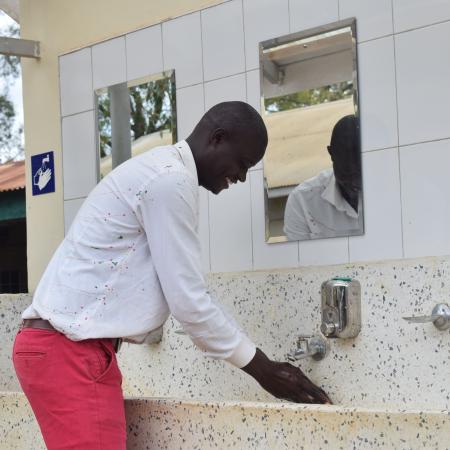
Sanitation for Millions implemented best practices in selected health care facilities (HCFs) in Apac cluster in Uganda, including construction of sanitary, handwashing (HWFs), and hospital waste management facilities, and systems for reliable water supply. Hardware was complemented by extensive awareness campaigns and trainings on water, sanitation, and hygiene (WASH) to foster improved knowledge and practices by patients and healthcare workers (HCWs), with a special focus on Infection Prevention and Control (IPC). The management was strengthened by adapting WHO/UNICEF’s standard tool WASHFIT and local guidelines for improved practices. Over the years valuable experiences and results on various levels were gathered.
District Health Officer Mr. Moses Ngura highlights: "As a cluster, we recognize substantial improvement in access to improved sanitation across all HCFs. This alongside awareness measures has triggered improved community health-seeking behavior.”
Capacity-building measures have prompted prioritization of WASH budgeting by the local government and have resulted in a change of attitude, mindset, and practices by both patients and HCWs. Health assistant Isabella Adongo states: “The IPC committee in our facility has been revitalized. I am proud to mention that it is fully functional and committed towards supporting WASH aspects which wasn’t the case before.”
Through regular health education coupled with attractive infrastructure, hygiene practices are improved on the patients’ side, proven by better toilet etiquette and the highly embraced hand washing practice. Outpatient Oruk Felix at Alenga Mission HCF notes: “The improvements in WASH have led to a cleaner facility, making it more attractive to patients compared to the time before”. This results in increased outpatient attendance. Ms. Jane Anyinge, a midwife in Aduku commends: “The trainings and the improved waste management facilities have made health care waste management practices more efficient, considering the referral facility handles over 90% of maternal deliveries in the Aduku cluster towns”.
The programme has indirectly improved the livelihoods of the skilled caretakers (Hausmeisters) that were trained in basic operation and maintenance of WASH infrastructure. This is attested by Ogwal Tom: “With the new skills, I support and rectify maintenance issues at several institutions and households, increasing my income streams to provide for my family better.”

